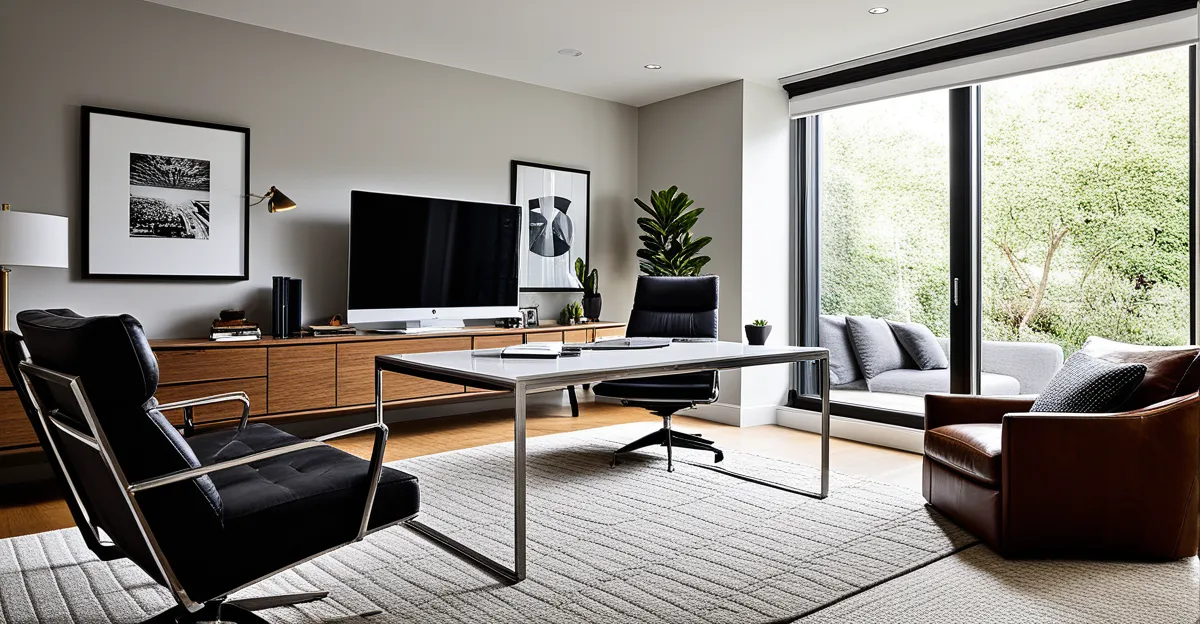Practical Steps for Converting Your Living Room into a Home Office
Transforming your living room into a functional home office setup begins with carefully assessing the available space and layout. Measure your area to understand where you can place your desk and other essential furniture without disrupting the flow of the room. Consider natural light sources, outlets, and how you will navigate around the space daily.
Identifying your essential home office needs is the next critical step. For remote work solutions, prioritize items such as a reliable desk, comfortable seating, adequate lighting, and storage for documents and tech accessories. Think about what tools you use most often and how you can keep them within easy reach to boost productivity.
Also read : How Can You Transform Your UK Home for Optimal Living?
Reorganising the space follows a step-by-step approach. Start by clearing the area you want to dedicate to work and remove any unnecessary furniture or clutter. Position your desk to take advantage of natural light and minimize distractions. Introduce storage options such as shelves or filing cabinets to keep the zone tidy. This living room transformation involves balancing the workspace with the existing functions of the room, maintaining comfort, and ensuring a clear separation from social areas. Proper planning at this stage will help create a seamless remote work solution that integrates well with your lifestyle.
Choosing Space-Saving and Functional Furniture
Selecting the right space-saving furniture is crucial when converting a living room into a productive home office setup. Multifunctional desks that fold or extend can adapt to your needs, providing enough work surface without occupying excessive space. For example, wall-mounted or compact desks combine functionality with minimal footprint, ideal for a living room transformation where every square foot counts.
Also read : How Can Innovative Storage Solutions Enhance UK Home Living?
Ergonomic office chairs contribute significantly to comfort and productivity in remote work solutions. Choosing chairs with adjustable height, lumbar support, and breathable materials helps reduce fatigue during long work hours. Even in tight spaces, slim-profile ergonomic chairs are available, ensuring proper posture without overwhelming the room.
Affordable and stylish furniture options do exist and are essential for balancing a useful workspace without compromising your living room’s aesthetics. Consider lightweight pieces that can be easily moved or stored when not in use, supporting flexibility between work and relaxation areas. With careful selection, you can create an efficient home office setup that enhances both comfort and style for your remote work demands.
Organisational Strategies for a Clutter-Free Workspace
Creating an effective home office organisation system is key to maintaining a productive and comfortable environment during your living room transformation. Start by incorporating smart storage solutions that optimise available space without crowding your work area. Vertical shelving units or wall-mounted organisers keep essentials within reach while freeing up floor space, vital for compact setups.
Cable clutter is a common issue in home offices, especially with multiple devices. Implementing dedicated cable management tools, such as cable trays, clips, or sleeves, helps route cords neatly and prevents tangling. This not only improves aesthetics but also reduces distractions and electrical hazards, supporting seamless remote work solutions.
Additionally, using desk organisers and drawer dividers can segment smaller office supplies, keeping your workspace tidy and efficient. By regularly decluttering and designating specific spots for each item, you cultivate a structured environment that boosts focus and productivity throughout your remote workday.
Zoning Tips to Balance Work and Home Life
Balancing work and personal time requires thoughtful zoning a home office within your living room. Defining clear boundaries between your workspace and relaxation areas is essential for maintaining a healthy work-life balance. This separation helps signal to your brain when it’s time to focus and when to unwind, reducing stress and improving productivity.
One effective method for establishing zones is through the use of room dividers. These can be physical partitions such as folding screens, bookcases, or even curtains that visually delineate your office space without permanently altering the room. For instance, a tall bookshelf between your desk and sofa creates a natural barrier while providing extra storage—combining functionality with zoning.
In addition to room dividers, strategic placement of furniture also aids in creating distinct areas. Positioning your desk so it faces away from your relaxation spots or using rugs to define the work zone can psychologically separate work from leisure. Rugs act as subtle visual cues that mark off your home office setup, making transitions between professional and personal time easier.
Maintaining a smooth transition further benefits from clear routines and habits tied to these zones. When you finish work, stepping away from your desk area symbolizes the end of your workday, helping protect your personal time. This approach supports sustainable remote work solutions by encouraging mental detachment and preventing burnout, even within a multi-use living room.
Lighting and Visual Design for Comfort and Productivity
Creating an effective home office setup in your living room demands careful attention to home office lighting and visual design to enhance productivity and comfort. Adequate lighting reduces eye strain and fatigue, essential for long hours of work in your living room transformation. Ideally, position your workspace near a natural light source to benefit from daylight, which boosts mood and concentration. However, daylight alone is rarely sufficient throughout the day, so incorporating layered artificial lighting is critical.
For artificial illumination, combine ambient, task, and accent lighting. A ceiling light provides overall brightness, while an adjustable desk lamp offers focused light for reading and computer work. Position lamps to minimize glare on screens and shadows on paperwork. Using bulbs with a daylight spectrum—around 5000K—can simulate natural lighting, which supports alertness and reduces strain.
Visual design also plays a vital role in remote work solutions. Choose colours and décor elements that inspire creativity but avoid overly stimulating patterns that distract attention. Neutral tones with small pops of colour can keep the space calming yet engaging. Incorporating plants or artwork adds personality while improving air quality and mental wellbeing.
In summary, balancing natural lighting with versatile artificial sources and thoughtful interior design creates a comfortable, visually appealing home office setup. This balance encourages productivity and well-being during your living room transformation, ultimately enhancing your remote work solutions.









